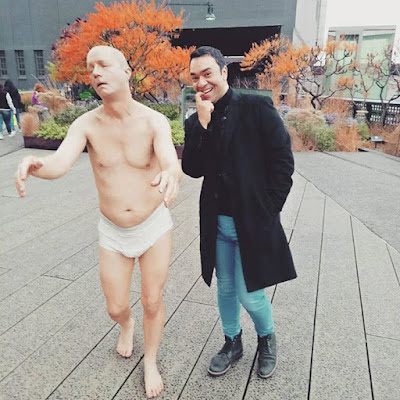 |
| Tony Matelli's Sleepwalker on the Highline Park, New York City |
Diverse Customer is now offering universal design consultancy creating a collaborative design space, a high sense of belonging, well-being, harmony & aesthetics promoting an environment that is focused on social inclusion and social cohesion. We have tied up with a bunch of inclusive: architects, designers, artisans amongst other professionals who have a monomaniacal focus on achieving inclusive design thinking bringing in the elements of cleanliness, discipline, inclusion, and belonging in all angles of accessibility. It helps to be a KonMari methodology fan. The KonMari Method popularized by Japanese organizing consultant and author, Marie Kondo is the tidying method created out of the passion for organizing. Its most unique characteristic is the question "does it spark joy?" which is the determining factor for deciding what to keep and what to give or throw away. However, that concept is a little evolved in our case to "does it spark Inclusion?"
As a practicing D&I coach, I am routinely asked about how organizations can make their workplaces more inclusive so as to instill a sense of belonging and well-being to everyone who walks into their door without feeling uncomfortable inside-out, disadvantaged, or discriminated upon (in extreme cases). Other than the inclusive, intercultural communications and culture integration aspects I work on, I kind of realized that inaccessible buildings and overwhelming interiors, and even, cluttered spaces create barriers to inclusive design and overall harmony. In short, the limited design and clutter is yet another contributor in perpetuating disparities and amplifying unease of accessibility for employees and customers.
Diverse Customer takes the concept of inclusive design thinking a notch up and also includes a sense of belonging, well-being and all the good things that must make part of our physical environment so that our mind, body, and soul are fully aligned and we operate as the best version of ourselves!
The methodology incorporates physical + spatial measures to effectively enhance an employee’s/ customer’s sense of belonging and well-being. We know what that sense of belonging translates to = Productivity, Profits, and Peace creating a people-centric inclusive/ universal and intuitive design (like intuitive furniture) and space that promotes physical and especially psychological wellbeing (like gender-neutral bathrooms) through Modularity, and Modernism. Delivering the following but not limited to: Facilitating Accessibility - Design & Development of the Inclusion Programs. We deliver inclusive design in our services to benefit diverse users through products and/or services that are accessible to, and usable by, as many people as reasonably possible … without the need for special adaptation or specialized design to accommodate for one specific person, in a controlled environment, or in a specific context.
Our team of inclusive designers also helps in facilitating access to premises servicing the needs and interests of visitors with a range of disabilities or needs including those with physical, sensory, intellectual, learning and psychosocial disabilities.
Ensure best practice, providing specialist advice towards the planning of galleries, exhibitions, and programs, and on specific aids and techniques available. To work closely with the Communications team to ensure that all materials are accessible within the framework are developed. Enhance awareness, sensitization and also to acquire practical skills and knowledge in order to offer accessible services. Ability to grasp pedagogical and aesthetic frameworks of pre-designed programs and the ability to adapt these to meet the global and universal accessibility standards.
-Amit Anand

Comments
Post a Comment
Thanks for commenting!